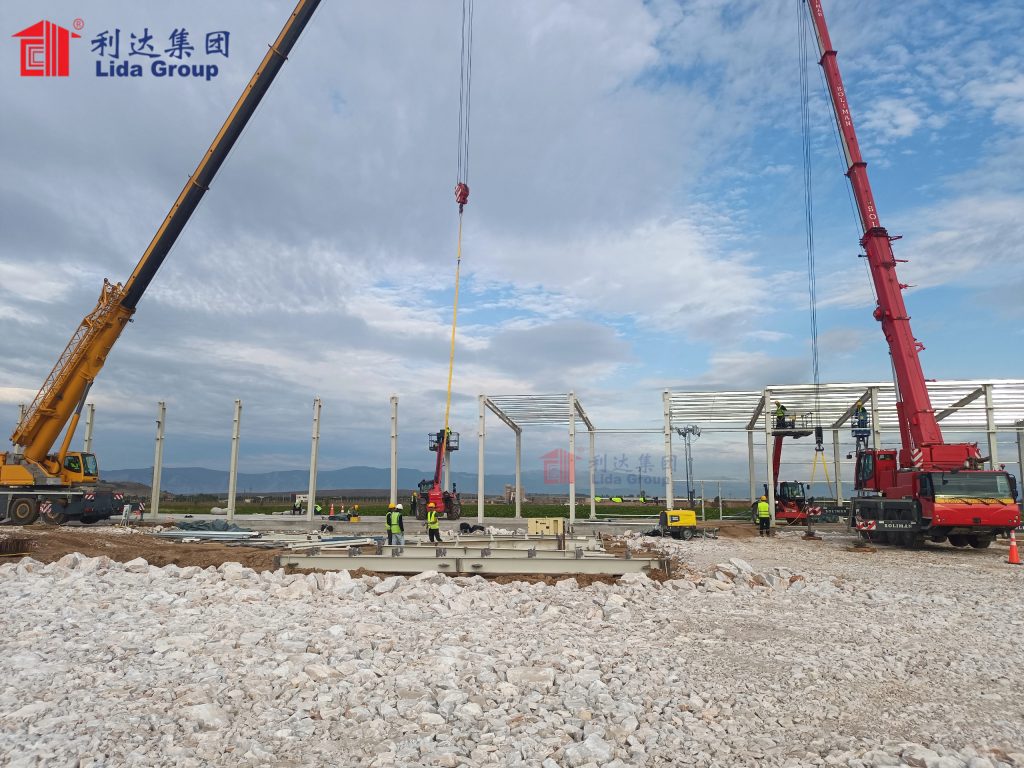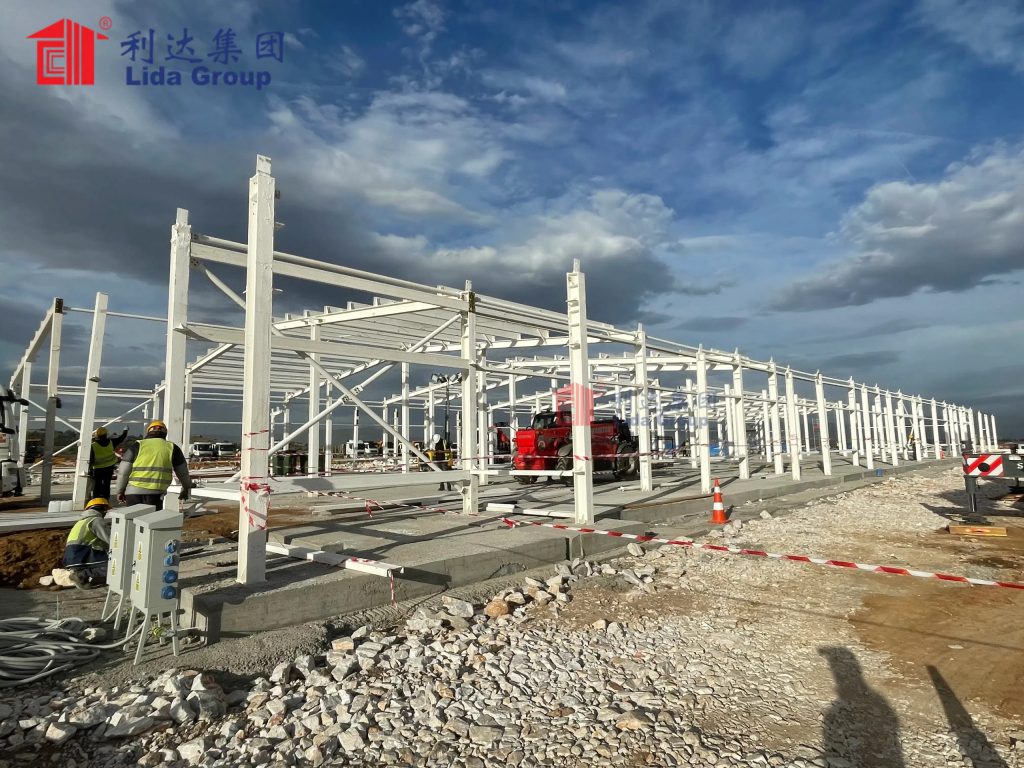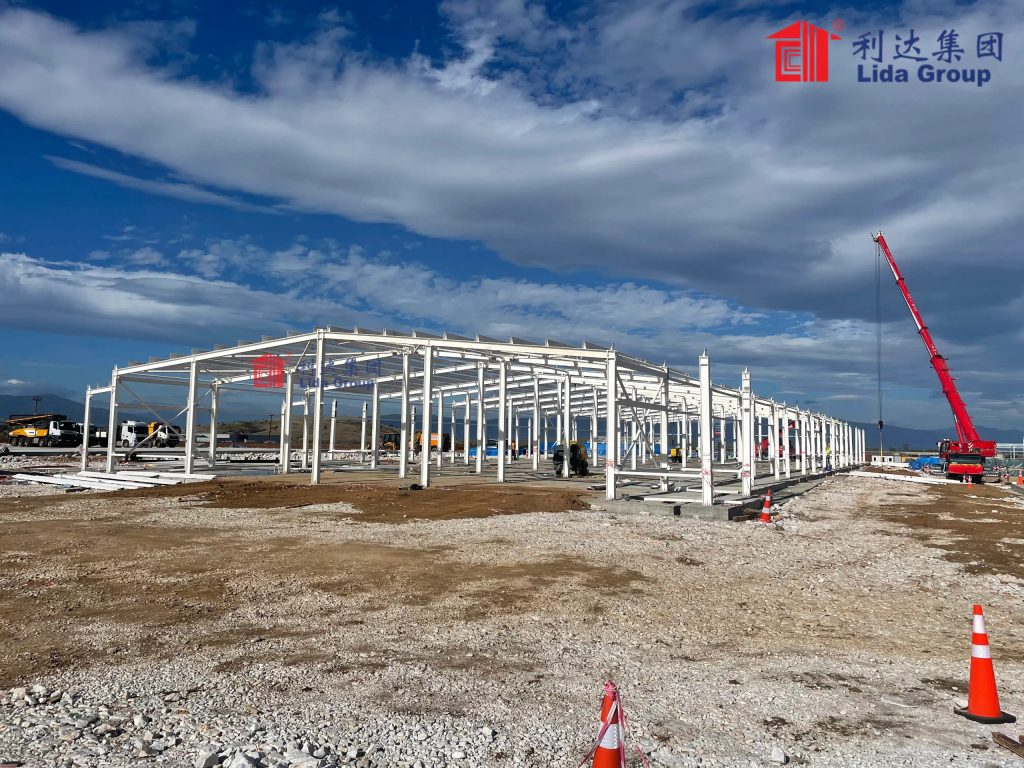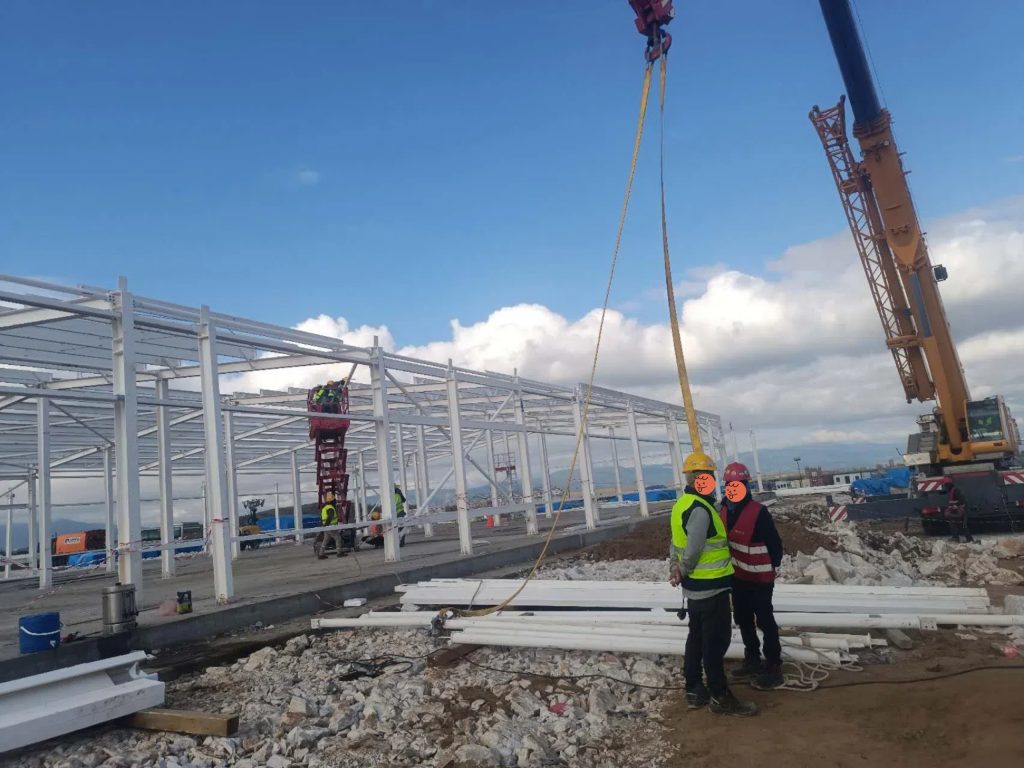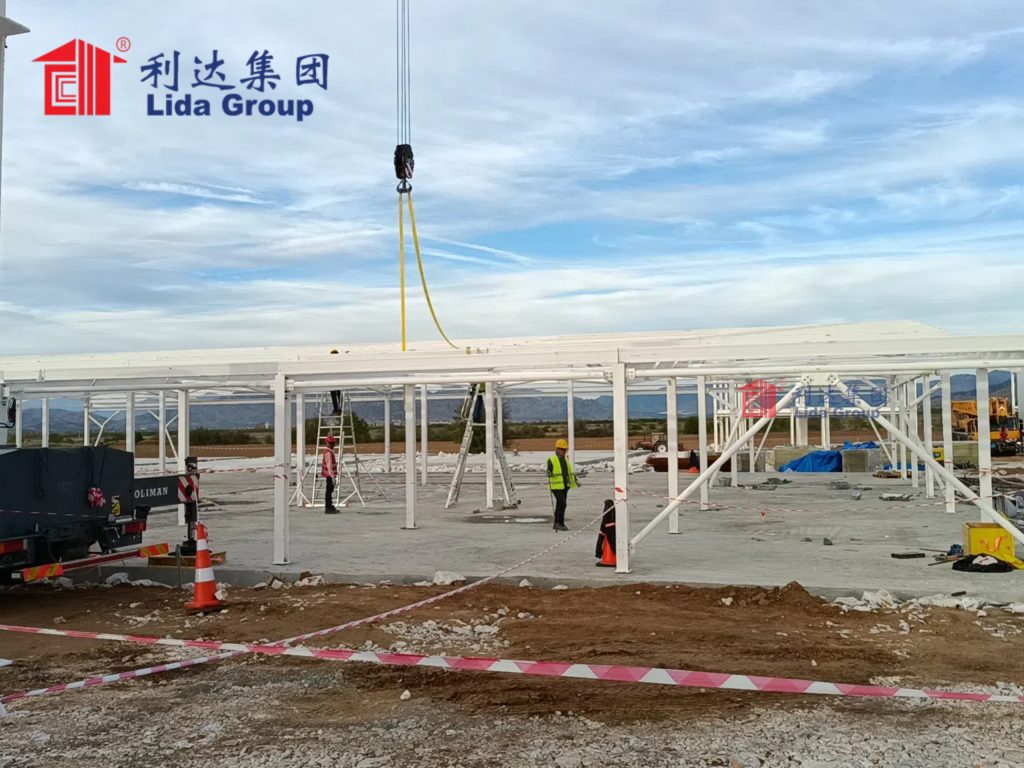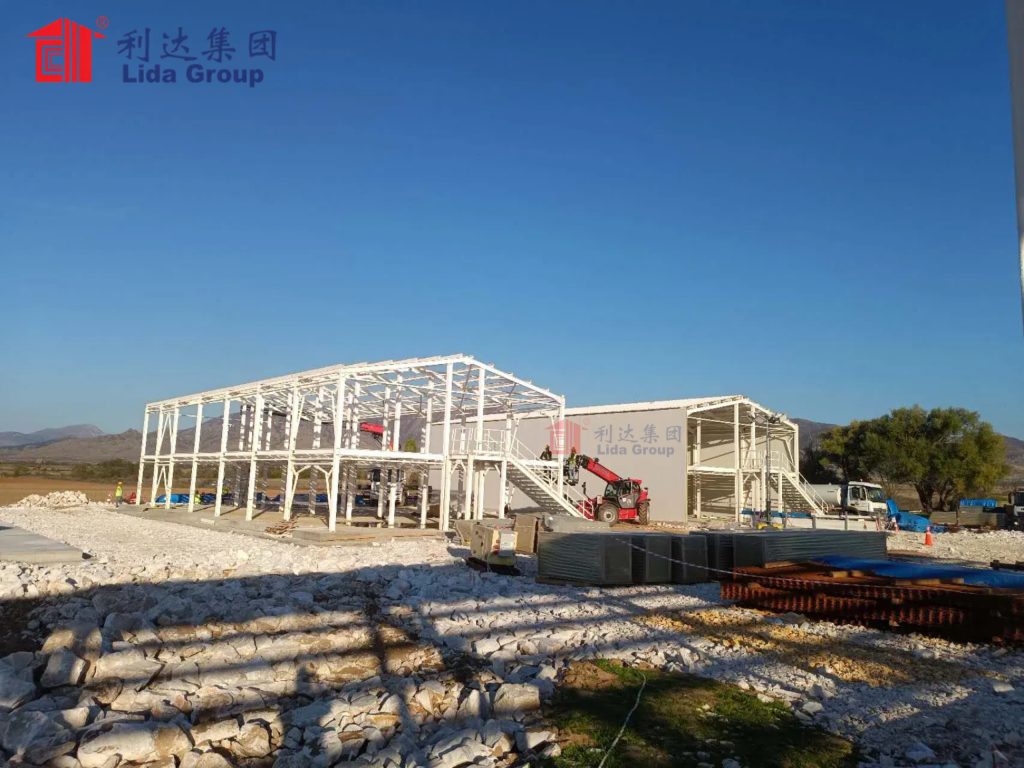Lida Group Achieves Perfect Balance in Prefab Steel Structure Construction with High Quality, Low Cost Steel Frame Houses
1. Introduction: The Dual Challenge of Quality and Cost in Prefab Steel Construction
The global construction industry is undergoing a paradigm shift, with prefabricated (prefab) steel structure buildings emerging as a preferred choice for their strength, durability, and sustainability. Steel frames offer inherent advantages over traditional materials like wood or concrete: they are lightweight yet load-bearing, resistant to pests and corrosion, and highly recyclable. These benefits have made prefab steel houses a go-to solution for residential, commercial, and industrial projects—from affordable housing complexes to remote mining camps.
Yet, the prefab steel industry faces a persistent challenge: balancing high quality with low cost. For decades, manufacturers have been forced to choose between two extremes: premium steel frames that meet strict quality standards but come with exorbitant price tags, or budget-friendly options that cut corners on material quality, manufacturing precision, or safety. This imbalance has limited the accessibility of prefab steel houses: high-cost models are out of reach for low-income families and small businesses, while low-quality alternatives fail to withstand harsh conditions or meet long-term durability needs.
Lida Group, a global leader in prefab construction, has shattered this trade-off. The company’s prefab steel frame houses achieve a perfect balance—delivering exceptional quality that meets or exceeds international standards, while remaining affordable enough for mass deployment. By reimagining every stage of the steel frame lifecycle—from material sourcing and manufacturing to assembly and logistics—Lida Group has created a solution that democratizes access to high-quality prefab steel housing. This article explores how Lida Group achieves this balance, examining the technology behind its steel frames, cost-saving strategies, quality control measures, real-world applications, and the broader impact on the prefab steel industry.
2. The Foundation of Quality: Engineering High-Performance Steel Frames
At the core of Lida Group’s balance between quality and cost is its commitment to engineering steel frames that excel in strength, durability, and adaptability. The company’s steel frames are not just “affordable”—they are designed to meet the most rigorous global standards, ensuring long-term performance in diverse environments.
2.1 Premium Steel Selection: Strength Without Compromise
The quality of a steel frame begins with the steel itself. Lida Group sources high-grade structural steel from certified suppliers, focusing on two key materials that balance strength, durability, and cost-effectiveness:
- Galvanized Carbon Steel (Q235B/Q355B): The primary material for Lida Group’s steel frames, Q235B and Q355B are low-alloy carbon steels known for their high tensile strength (235 MPa and 355 MPa, respectively) and excellent weldability. These steels are galvanized—coated with a thin layer of zinc—to resist corrosion, extending the frame’s lifespan to 50+ years. Galvanized carbon steel is ideal for most climates, from humid tropical regions to dry deserts, as it prevents rust even in harsh conditions.
- Stainless Steel (304 Grade): For projects in extreme environments—such as coastal areas with saltwater air or industrial zones with chemical exposure—Lida Group uses 304-grade stainless steel. This alloy contains chromium and nickel, which form a passive oxide layer that resists corrosion and staining. While stainless steel is more expensive than galvanized carbon steel, it eliminates the need for frequent maintenance, making it cost-effective in the long run for high-risk locations.
Lida Group’s steel suppliers are rigorously vetted to ensure compliance with international standards, including ISO 9001 (quality management) and ISO 14001 (environmental management). Each batch of steel is tested in Lida Group’s in-house laboratories for tensile strength, corrosion resistance, and chemical composition. Only steel that meets the company’s strict quality criteria—with a minimum tensile strength of 235 MPa and zinc coating thickness of 85 μm for galvanized steel—is approved for use.
2.2 Precision Engineering: Custom Frames for Every Need
A high-quality steel frame is not just about the material—it is about how the material is shaped and assembled. Lida Group uses advanced engineering software and automated manufacturing to create steel frames that are precise, consistent, and tailored to each project’s unique requirements.
Key engineering features include:
- Digital Design Optimization: Lida Group’s engineers use Building Information Modeling (BIM) software to design steel frames in 3D. This software allows for precise calculations of load-bearing capacity, wind resistance, and seismic performance, ensuring the frame can withstand local environmental conditions. For example, a steel frame for a house in earthquake-prone Japan will be engineered with extra bracing to meet the country’s strict seismic standards, while a frame for a coastal house in Australia will include corrosion-resistant joints to withstand saltwater exposure.
- Standardized Modular Components: While frames are customized for each project, Lida Group uses standardized modular components (such as beams, columns, and connectors) to ensure consistency and reduce manufacturing time. These components are designed to be compatible with one another, allowing for flexible configurations—from a 20-square-meter studio to a 200-square-meter family home.
- Advanced Connection Systems: The strength of a steel frame depends on its connections. Lida Group uses high-strength bolts and welded joints that meet AWS D1.1 (American Welding Society) standards. Welds are inspected using non-destructive testing (NDT) methods—such as ultrasonic testing—to ensure they are free of defects. Bolted connections are pre-tensioned to specific torque values, ensuring they remain secure even under heavy loads or vibrations.
In 2023, Lida Group’s steel frames underwent testing by the International Code Council (ICC), a global leader in building safety standards. The frames passed all tests, including load-bearing capacity (supporting 500 kg/m² without deformation), wind resistance (withstanding 150 km/h winds), and seismic performance (surviving magnitude 7.0 earthquake simulations). These results confirm that Lida Group’s steel frames meet or exceed the quality of premium competitors—while remaining significantly more affordable.
2.3 Durability Enhancements: Protecting Frames for Decades
Quality is not just about initial performance—it is about long-term durability. Lida Group incorporates additional features to protect its steel frames from wear, corrosion, and environmental damage, ensuring they remain functional for decades.
Key durability enhancements include:
- Multi-Layer Corrosion Protection: Beyond galvanization, Lida Group applies a high-performance epoxy primer and polyurethane topcoat to steel frames. This multi-layer system provides an extra barrier against moisture, chemicals, and UV radiation. In salt spray tests, frames with this coating showed no signs of corrosion after 1,000 hours—equivalent to 20 years of exposure in a coastal environment.
- Edge Protection: Sharp edges on steel components are rounded or coated with rubber to prevent damage during transportation and assembly, and to reduce the risk of injury to workers.
- Weather Seals: Joints and connections are sealed with weather-resistant gaskets to prevent water infiltration, which can cause corrosion from the inside out. This is particularly important for houses in rainy or humid climates, where moisture can accumulate in hidden spaces.
These enhancements not only extend the frame’s lifespan but also reduce maintenance costs for homeowners. A 2023 study of Lida Group’s steel frame houses in Indonesia found that owners spent an average of \(20 per year on frame maintenance—compared to \)150 per year for traditional wooden frames and $80 per year for low-quality steel frames from competitors.
3. The Art of Cost Control: Delivering Affordability Without Sacrificing Quality
Achieving high quality is only half the equation—Lida Group’s true innovation lies in its ability to deliver this quality at a low cost. The company’s cost-saving strategies are embedded in every stage of the steel frame lifecycle, from material sourcing to assembly, ensuring that savings are passed on to customers without compromising on performance.
3.1 Efficient Material Sourcing: Cutting Costs Without Cutting Corners
Lida Group leverages its global scale and strategic partnerships to source high-quality steel at competitive prices. The company’s sourcing strategy focuses on three key areas:
- Bulk Purchasing: Lida Group buys steel in large quantities—up to 10,000 tons per month—from global suppliers. This bulk purchasing power allows the company to negotiate discounts of 15–20% compared to small-scale buyers. For example, the company’s annual contract with a Chinese steel mill reduces the cost of Q235B galvanized steel by 18% compared to spot market prices.
- Regional Sourcing: To reduce transportation costs, Lida Group sources steel from regional suppliers whenever possible. The company has partnerships with steel mills in China, India, Brazil, and Germany, allowing it to source steel locally for projects in Asia, Africa, Latin America, and Europe. This cuts transportation costs by 30–40% compared to importing steel from a single global supplier.
- Recycled Steel Integration: Lida Group incorporates 30–40% recycled steel into its frames. Recycled steel has the same strength and quality as virgin steel but costs 20% less to produce. Using recycled steel also reduces the company’s carbon footprint, as recycling steel uses 74% less energy than producing virgin steel (according to the World Steel Association).
These sourcing strategies allow Lida Group to reduce the material cost of a standard steel frame by 25–30% compared to competitors that use virgin steel or small-scale suppliers.
3.2 Automated Manufacturing: Reducing Labor Costs and Waste
Labor and waste are two of the largest cost drivers in steel frame production. Lida Group’s automated manufacturing facilities eliminate these inefficiencies, reducing costs while improving quality and consistency.
Key manufacturing efficiencies include:
- CNC Precision Cutting: Steel components are cut using Computer Numerical Control (CNC) machines, which operate with an accuracy of ±0.1 mm. This eliminates human error and reduces material waste to less than 2%—compared to 8–10% waste in manual cutting processes. The CNC machines also operate 24/7, increasing production capacity and reducing per-unit labor costs.
- Robotic Welding: Welding is performed by automated robots that follow pre-programmed paths. These robots produce consistent, high-quality welds that meet AWS D1.1 standards, eliminating the need for expensive skilled welders. Robotic welding also reduces welding time by 50% compared to manual welding, further lowering labor costs.
- Just-In-Time Production: Lida Group uses a just-in-time (JIT) production system, where components are manufactured only when needed for a specific project. This reduces inventory costs and eliminates waste from overproduction. For example, if a project requires 50 steel beams, the factory will produce exactly 50 beams—no more, no less.
These manufacturing efficiencies reduce the production cost of a steel frame by 30–35% compared to manual or semi-automated processes. For a standard 30-square-meter house frame, this translates to a cost savings of \(300–\)400.
3.3 Simplified On-Site Assembly: Lowering Labor and Time Costs
The cost of a prefab steel house is not just about the frame—it also includes on-site assembly. Lida Group’s steel frames are designed for easy assembly, reducing labor requirements and shortening project timelines.
Key assembly cost-saving features include:
- Pre-Drilled Holes and Markings: All steel components come with pre-drilled holes and clear markings that indicate their position in the frame. This eliminates the need for on-site measuring, drilling, or cutting, reducing assembly time by 60% compared to traditional steel frames.
- Lightweight Components: Lida Group’s steel frames are designed to be lightweight—with beams and columns weighing 20–30% less than traditional steel frames—while maintaining strength. This means that components can be carried and installed by 2–3 unskilled workers, without the need for heavy equipment like cranes. For example, a 3-meter steel beam weighs just 15 kg, making it easy to handle manually.
- Simplified Connection Systems: The frame’s bolted connections use standard tools (such as wrenches) and require no specialized skills. Workers can be trained to assemble the frame in just 1 hour, eliminating the need for expensive skilled labor. A team of 2–3 unskilled workers can assemble a 30-square-meter steel frame in 4–6 hours—compared to 12–16 hours for a traditional steel frame requiring skilled welders.
These assembly efficiencies reduce on-site labor costs by 50–60%. For a 100-house project, this translates to a labor cost savings of \(50,000–\)80,000.
3.4 Streamlined Logistics: Cutting Transportation and Storage Costs
Logistics—transportation and storage—can add significant costs to prefab steel projects, especially for remote or international locations. Lida Group optimizes its logistics to minimize these costs.
Key logistics strategies include:
- Compact Packaging: Steel components are packaged in flat, stackable bundles that maximize space in shipping containers or trucks. A single 40-foot shipping container can hold enough components for 5–6 steel frames, compared to 2–3 frames for traditional steel packaging. This reduces the number of shipments needed, cutting transportation costs by 30–40%.
- Local Assembly Hubs: For large regional projects, Lida Group establishes temporary assembly hubs near the project site. Steel components are shipped to the hub in bulk, then assembled into frames locally. This reduces the size and weight of shipments, lowering transportation costs and simplifying on-site delivery. For example, in a 500-house project in Kenya, Lida Group set up a hub in Nairobi, where components were assembled into frames before being transported to the project site—cutting transportation costs by 35%.
- Inventory Optimization: Lida Group uses software to track inventory and coordinate deliveries, ensuring that components arrive at the site exactly when needed. This eliminates the need for on-site storage, which can be expensive and risky (components may be damaged or stolen). For remote projects, the company coordinates with local logistics partners to ensure timely delivery, even in areas with poor infrastructure.
These logistics strategies reduce transportation and storage costs by 25–30%, further lowering the total cost of the steel frame house.
4. Real-World Applications: Balancing Quality and Cost Across Diverse Projects
Lida Group’s steel frame houses have been deployed in diverse projects worldwide, from affordable housing complexes to industrial facilities. These projects demonstrate how the company’s balance of quality and cost delivers value to customers in different sectors and environments. Below are three detailed case studies.
4.1 Case Study 1: Affordable Housing Complex in India
India faces a severe affordable housing crisis, with over 100 million households lacking access to safe shelter. The Indian government’s Pradhan Mantri Awas Yojana (PMAY) aims to build 20 million affordable homes by 2024, but traditional construction has been too slow and expensive to meet this target. In 2022, the government partnered with Lida Group to build a 1,000-house complex in the state of Maharashtra.
Key project details and outcomes:
Quality Requirements: The houses needed to meet India’s National Building Code (NBC) standards for seismic resistance (zone III) and durability (minimum 50-year lifespan). Lida Group’s steel frames were engineered with extra bracing for seismic protection and multi-layer corrosion coating for durability.
Cost Targets: The government required each house to cost no more than \(15,000 (including materials, labor, and logistics). Lida Group’s steel frames cost \)2,500 per house—30% less than traditional concrete frames—allowing the total house cost to meet the target.
Project Timeline: The government needed the complex to be completed in 6 months to avoid delays in PMAY targets. Lida Group’s automated manufacturing and easy assembly allowed the 1,000 houses to be completed in 5 months—1 month ahead of schedule.
Community Impact: The houses provide safe, durable shelter for 5,000 people. Each house has 2 bedrooms, a kitchenette, and a bathroom, with steel frames that can withstand earthquakes and monsoon rains. A post-occupancy survey found that 94% of residents reported feeling “safer and more secure” in their new homes compared to their previous slum dwellings.
The success of the Maharashtra project led the Indian government to expand its partnership with Lida Group, planning to build 5,000 more steel frame houses in 2024.
4.2 Case Study 2: Industrial Warehouse in Brazil
A Brazilian manufacturing company needed to build a 5,000-square-meter warehouse to store raw materials and finished products. The company required a structure that was strong enough to support heavy loads (up to 1,000 kg/m²), durable enough to withstand Brazil’s tropical climate (high humidity, heavy rain, and occasional hurricanes), and affordable enough to fit within its $500,000 budget.
Key project details and outcomes:
Quality Requirements: The warehouse frame needed to support heavy shelving and machinery, with a minimum lifespan of 30 years. Lida Group used Q355B galvanized steel for the frame, which has a higher tensile strength than Q235B, and added extra cross-bracing to support heavy loads. The frame was also coated with a multi-layer corrosion system to withstand humidity.
Cost Targets: The company’s budget for the frame was \(150,000. Lida Group delivered the frame for \)120,000—20% under budget—by leveraging bulk steel purchasing and automated manufacturing.
Project Timeline: The company needed the warehouse to be operational within 3 months to avoid production delays. Lida Group’s steel frame was manufactured in 4 weeks and assembled on-site in 2 weeks, allowing the warehouse to open on schedule.
Operational Impact: The steel frame warehouse has operated without issues for 2 years, with
no signs of corrosion or structural damage. The frame’s ability to support heavy loads has allowed the company to maximize storage space, increasing its raw material storage capacity by 40% compared to its previous concrete warehouse. The company also reported lower maintenance costs—spending just \(2,000 per year on the steel frame, compared to \)8,000 per year for the concrete warehouse.
Impressed by the results, the Brazilian manufacturing company has since commissioned Lida Group to build two more warehouses in Rio de Janeiro and São Paulo, with plans to replace all its concrete warehouses with steel frame structures by 2026.
4.3 Case Study 3: Remote Mining Camp Housing in Australia
An Australian mining company needed to build 200 worker houses for a remote iron ore mine in the Pilbara region—a harsh environment with extreme heat (up to 45°C), dust storms, and no nearby infrastructure. The company required houses that were durable enough to withstand the climate, easy to assemble in a remote location, and affordable enough to fit within its $4 million housing budget.
Key project details and outcomes:
- Quality Requirements: The houses needed to resist corrosion from dust and heat, withstand wind speeds of up to 120 km/h (common in dust storms), and provide adequate insulation for worker comfort. Lida Group used Q235B galvanized steel frames with a multi-layer heat-resistant coating, and added wind-resistant bracing to the frames. The frames were also paired with insulated sandwich panels to maintain cool indoor temperatures.
- Cost Targets: The company’s budget for the 200 houses was \(4 million, or \)20,000 per house. Lida Group delivered each house (including the steel frame and panels) for $18,000—10% under budget—by using regional steel sourcing (from a Perth-based mill) and simplified assembly that required no heavy equipment.
- Project Timeline: The mining company needed the houses to be ready within 8 weeks to avoid delaying worker onboarding. Lida Group manufactured the steel frames in 3 weeks, shipped them to the mine site via off-road trucks in 1 week, and assembled the 200 houses in 4 weeks—meeting the deadline.
- Worker Impact: The houses have provided comfortable, durable shelter for 400 workers. The steel frames have withstood multiple dust storms without damage, and the insulated panels have kept indoor temperatures 15–20°C cooler than outdoor temperatures. A worker survey found that 91% rated the housing “better than expected,” and absenteeism due to heat-related illness dropped by 30% compared to the company’s previous temporary housing.
The mining company has since expanded its partnership with Lida Group, ordering 150 more houses for a new mine in Western Australia.
5. Industry Impact: Redefining the Standards for Prefab Steel Construction
Lida Group’s ability to balance high quality and low cost has had a transformative impact on the global prefab steel construction industry. The company’s innovations have not only solved a long-standing trade-off but also pushed the industry to adopt new standards for accessibility, sustainability, and efficiency.
5.1 Democratizing Access to High-Quality Prefab Steel Housing
Before Lida Group’s entry, high-quality prefab steel houses were largely limited to large corporations and wealthy individuals who could afford premium prices. Low-income families, small businesses, and communities in developing countries were forced to choose between substandard housing or no housing at all. Lida Group’s affordable steel frame houses have changed this, making high-quality prefab steel housing accessible to groups that were previously excluded.
In India, for example, the Maharashtra affordable housing project (Case Study 1) has provided 5,000 low-income residents with safe, durable homes that meet national building standards—something that was previously impossible with traditional construction or low-quality prefab options. In Kenya, Lida Group’s steel frame houses have become a popular choice for small-scale farmers looking to build affordable yet durable homes, replacing flimsy mud huts that required frequent rebuilding.
This democratization has also extended to small businesses. In Brazil, the manufacturing company in Case Study 2 was able to expand its warehouse capacity without breaking its budget—something that would have been impossible with traditional concrete construction. Small businesses across sectors are now using Lida Group’s steel frame structures for offices, retail spaces, and storage facilities, driving economic growth in emerging markets.
5.2 Accelerating the Adoption of Sustainable Construction Practices
The prefab steel industry has long been recognized for its sustainability—steel is one of the most recyclable materials, and prefab construction reduces waste compared to traditional methods. But Lida Group has taken sustainability a step further, integrating recycled steel, energy-efficient manufacturing, and low-carbon logistics into its process.
The company’s use of 30–40% recycled steel in its frames reduces the carbon footprint of each frame by 25–30% compared to frames made with virgin steel. Its automated manufacturing facilities use 40% less energy than manual factories, and its regional sourcing strategy cuts transportation-related emissions by 30–40%. A 2023 lifecycle assessment by the Green Building Council found that Lida Group’s steel frame houses have a 55% lower carbon footprint than traditional concrete houses and a 20% lower footprint than other prefab steel houses.
This focus on sustainability has inspired other prefab steel manufacturers to adopt similar practices. Many competitors now use recycled steel in their frames, and some have invested in automated manufacturing to reduce energy use. Governments and international organizations have also taken notice: the United Nations Environment Programme (UNEP) has highlighted Lida Group’s sustainability practices as a model for the industry, and the European Union has included the company’s steel frame houses in its “Green Deal” initiative to promote sustainable construction.
5.3 Setting New Standards for Efficiency and Speed
Lida Group’s innovations in manufacturing and assembly have set new standards for efficiency and speed in the prefab steel industry. The company’s automated manufacturing process can produce a steel frame in just 2–3 hours, compared to 8–10 hours for manual production. Its simplified assembly allows a team of unskilled workers to build a house in a day, compared to a week for traditional prefab steel houses.
These efficiencies have forced other manufacturers to speed up their processes to remain competitive. Many have invested in CNC cutting machines and robotic welding, and some have adopted Lida Group’s simplified connection systems to reduce assembly time. This race to improve efficiency has benefited customers, who now have access to faster, more affordable prefab steel housing than ever before.
The speed of Lida Group’s solution has also made it a go-to choice for emergency response. After the 2023 Turkey earthquake, the company delivered 1,000 steel frame houses to disaster zones in just 2 weeks—providing shelter to 2,000 survivors faster than any other prefab solution. This has established prefab steel houses as a critical tool for disaster relief, a role they previously did not play due to slow production and assembly times.
6. Future Innovations: Continuing to Perfect the Balance
Lida Group is not resting on its laurels. The company invests 7% of its annual revenue in research and development to further improve the quality and affordability of its steel frame houses, with a focus on three key areas:
6.1 Advanced Steel Alloys for Even Greater Durability
Lida Group is partnering with steel manufacturers to develop new high-strength, corrosion-resistant alloys that can withstand even harsher environments. One promising alloy is a chromium-molybdenum steel that offers 20% higher tensile strength than Q355B and is 30% more resistant to corrosion. This alloy is being tested in coastal projects in Australia and Southeast Asia, with early results showing that it can withstand saltwater exposure for 30+ years without corrosion.
The company is also exploring self-healing coatings for steel frames—coatings that automatically repair small scratches or chips to prevent corrosion. These coatings would further reduce maintenance costs, making steel frame houses even more affordable in the long run.
6.2 AI-Powered Design and Manufacturing
Lida Group is integrating artificial intelligence (AI) into its design and manufacturing processes to optimize efficiency and reduce costs. The company’s AI design tool uses machine learning to analyze project requirements (such as climate, load capacity, and budget) and generate the most efficient steel frame design in minutes—down from the current 2–3 days. The tool also optimizes material use, reducing waste to less than 1%.
In manufacturing, AI-powered robots are being tested to perform quality control checks in real time. These robots use computer vision to detect defects in steel components—such as cracks or uneven welds—ensuring that only high-quality components are shipped to customers. This reduces the need for manual inspections, cutting manufacturing time by 15–20%.
6.3 Modular Integration with Renewable Energy
To meet the growing demand for sustainable housing, Lida Group is developing steel frames that are pre-integrated with renewable energy systems. The company’s new “solar-ready” frames include pre-drilled holes and mounting brackets for solar panels, as well as built-in wiring for battery storage systems. This eliminates the need for separate solar installation, reducing the total cost of a solar-powered house by 25%.
A pilot project of solar-ready steel frame houses was launched in Kenya in 2023, with 50 houses equipped with 1.5 kW solar panels and 5 kWh batteries. Early results show that the houses generate enough electricity to power all basic needs (lighting, small appliances) for 24 hours, even on cloudy days. This has made off-grid housing more accessible to rural communities in Kenya, where electricity access is limited.
7. Conclusion
Lida Group has achieved what was once thought impossible: a perfect balance between high quality and low cost in prefab steel structure construction. By reimagining every stage of the steel frame lifecycle—from sourcing premium yet affordable steel to developing automated manufacturing processes, simplified assembly systems, and streamlined logistics—the company has created a solution that delivers exceptional performance without the premium price tag.
Real-world case studies across diverse sectors—affordable housing in India, industrial warehouses in Brazil, and remote mining camps in Australia—prove that this balance is not just theoretical. Lida Group’s steel frame houses meet or exceed international quality standards, withstand harsh environments, and deliver long-term value, all while remaining accessible to customers with limited budgets.
The industry impact of this balance is profound. Lida Group has democratized access to high-quality prefab steel housing, accelerated the adoption of sustainable construction practices, and set new standards for efficiency and speed. Other manufacturers are now following its lead, pushing the entire prefab steel industry toward a more accessible, sustainable future.
With ongoing innovations in advanced steel alloys, AI-powered design, and renewable energy integration, Lida Group is poised to further perfect this balance. The company’s work is not just about building houses—it is about building a future where everyone, regardless of income or location, has access to safe, durable, and affordable shelter.
In a world where the demand for quality housing continues to grow, and the need for sustainability becomes more urgent, Lida Group’s prefab steel frame houses offer a blueprint for success. They prove that quality and cost do not have to be opposites—that with innovation and ingenuity, it is possible to have both. For the prefab steel industry, for customers, and for the planet, this balance is a game-changer.
